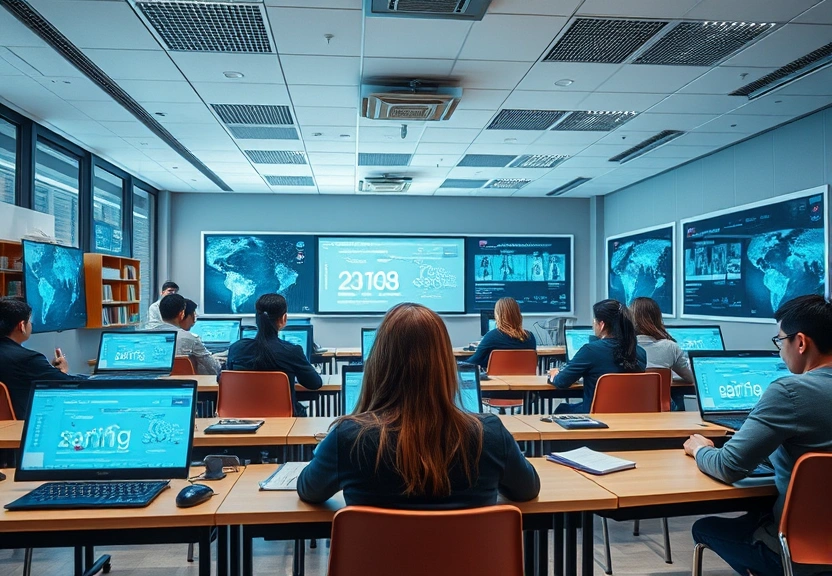The Future of Classrooms: Trends in Smart Learning Environments Revolutionizing Education
Imagine a classroom where learning isn’t limited by walls or even geography. Picture a setting where each student’s unique needs are met through personalized, technology-driven approaches. You’ve likely experienced the traditional classroom model, with its rows of desks and standard chalkboards. But now, consider what your educational journey might have been like if you’d had access to a smart learning environment. How might your engagement and understanding have blossomed with technology that adapts to your learning style?

It’s natural to feel nostalgic about your school days, yet there’s an exciting wave of change sweeping through education. This change is not just about including gadgets in lesson plans; it’s about creating a holistic, immersive experience that speaks to the way you naturally interact with the world today. Smart learning environments are bridging the gap between traditional education and the innovative teaching methods that cater to the needs of the digital native generation.
In this article, we will delve into how these environments are being crafted to make learning more interactive, engaging, and inclusive. Whether you’re a parent, teacher, or just someone interested in the future of education, understanding these shifts can help you better support students in navigating their educational journeys. Let’s embark on a journey to explore how trends in education technology are revolutionizing classrooms, inspiring a learning experience that resonates on a personal level. This shift isn’t just about technology; it’s about creating a space where learning becomes a truly personalized and transformative experience.
Understanding Smart Learning Environments
Defining Smart Learning Environments
Smart learning environments are more than just classrooms outfitted with the latest gadgets. They are dynamic settings that integrate innovative teaching methods with advanced technologies to support personalized and effective learning experiences.
- Utilize digital platforms to tailor resources to individual learning styles.
- Incorporate adaptive learning technologies that respond to students’ progress and comprehension levels.
- Create interactive and immersive learning experiences through the use of augmented reality (AR) and virtual reality (VR).
Core Components of Smart Learning Environments
These environments are built upon several key elements that work together to support enhanced learning outcomes.
- Tech-Integration: Seamless integration of digital tools like tablets, computers, and interactive whiteboards.
- Data-Driven Insights: Using analytics to track student progress and tailor educational strategies accordingly.
- Collaborative Spaces: Designing spaces that encourage collaboration and communication among students.
The Role of Teachers in Smart Learning Environments
In the context of smart learning environments, the role of teachers transforms from being the sole source of knowledge to facilitators of learning.
- Guide and support students through personalized learning paths.
- Utilize data to identify areas where students need additional support or challenges.
- Encourage critical thinking and problem-solving skills by fostering inquiry-based learning.
Key Trends Driving Smart Learning Environments
Artificial Intelligence and Machine Learning
AI and machine learning are at the forefront of smart learning environments, enabling personalized educational experiences that adapt in real-time.
- AI-driven platforms analyze student performance to customize learning materials.
- Machine learning algorithms help predict future learning challenges and suggest interventions.
- Intelligent tutoring systems provide additional support outside of traditional class times.
Internet of Things (IoT) in Education
The Internet of Things connects physical devices to the internet, creating a network of interconnected tools that support learning.
- Smart Desks: Desks equipped with sensors to monitor student engagement and physical activity.
- Interactive Devices: Devices that facilitate real-time feedback and collaboration among students and teachers.
- Environmental Sensors: Tools that ensure optimal learning conditions, such as temperature and lighting.
Social Emotional Learning (SEL) Technologies
Integrating SEL technologies into smart learning environments addresses the emotional and social aspects of learning.
- Platforms that assess and support students’ emotional well-being.
- Tools that promote empathy, communication, and teamwork through interactive exercises.
- Apps that provide feedback on social skills and emotional intelligence.
🎥 Vídeo complementar sobre o tópico
Benefits of Smart Learning Environments
Personalized Learning Experiences
One of the standout advantages of smart learning environments is the ability to offer personalized learning experiences that cater to individual student needs.
- Adaptive learning technologies adjust the pace and content based on student performance.
- Students receive instant feedback, allowing for timely interventions and support.
- Learning paths can be customized to align with students’ interests and career aspirations.
Enhanced Engagement and Motivation
Engagement in smart learning environments is not just about content delivery but making learning an exciting and motivating experience.
- Gamification: Integrating game-like elements to make learning fun and engaging.
- Interactive Content: Using multimedia resources to create a stimulating learning atmosphere.
- Collaborative Projects: Encouraging teamwork and problem-solving through group assignments.
Improved Accessibility and Inclusivity
Smart learning environments also focus on ensuring that education is accessible and inclusive for all students, regardless of their backgrounds or abilities.
- Assistive technologies support students with disabilities, providing alternative ways to engage with content.
- Online platforms offer remote access to learning materials for students in different geographic locations.
- Multilingual resources help cater to students from diverse linguistic backgrounds.
Challenges and Considerations
Ensuring Data Privacy and Security
With the increased use of technology in education, ensuring the privacy and security of student data is a primary concern.
- Implement robust cybersecurity measures to protect sensitive information.
- Educate students and staff on safe digital practices and data protection.
- Regularly review and update privacy policies to comply with regulations.
Addressing the Digital Divide
The digital divide remains a significant barrier to fully realizing the benefits of smart learning environments, particularly in underserved communities.
- Invest in infrastructure to provide reliable internet access in all areas.
- Ensure equitable distribution of digital devices to all students.
- Provide training and support for students and teachers unfamiliar with technology.
Balancing Screen Time and Offline Activities
While technology is integral to smart learning environments, it’s essential to balance screen time with offline activities to promote holistic development.
- Incorporate physical activities into the daily schedule to enhance physical health.
- Encourage offline group projects to develop social and communication skills.
- Provide guidelines for managing screen time to prevent digital fatigue.

Frequently Asked Questions About Smart Learning Environments
What is a smart learning environment?
A smart learning environment is an educational setting that incorporates advanced technology to create dynamic, engaging, and personalized learning experiences. It uses tools such as AI, IoT, and adaptive learning platforms to tailor education to the needs of each student.
How do smart learning environments improve student engagement?
These environments increase engagement by using interactive tools and multimedia content that make learning more exciting and relatable. Gamification and collaborative projects also play a significant role in keeping students motivated and interested in their education.
Can smart learning environments accommodate students with special needs?
Yes, smart learning environments are designed to be inclusive, offering assistive technologies and adaptive tools that support students with disabilities. These technologies provide alternative ways to engage with content and ensure that all students have access to quality education.
What role do teachers play in smart learning environments?
Teachers in smart learning environments act as facilitators, guiding students through personalized learning paths and using data-driven insights to support individual learning needs. They focus on fostering critical thinking and problem-solving skills in students.
How does AI contribute to smart learning environments?
AI contributes by personalizing learning experiences and providing real-time insights into student performance. It helps educators identify learning gaps and suggests specific interventions or resources to enhance the educational process.
What challenges do educators face in implementing smart learning environments?
Educators often face challenges such as ensuring data privacy, addressing the digital divide, and balancing technology use with traditional teaching methods. They must also receive adequate training to effectively integrate new technologies into the classroom.
What are the benefits of incorporating IoT in education?
IoT enhances educational experiences by creating interconnected learning tools and environments. It allows for real-time data collection and analysis, improving the efficiency of educational processes and ensuring optimal learning conditions.
How do smart learning environments address accessibility issues?
These environments employ technologies like text-to-speech and other assistive tools to cater to students with varying needs. They also make use of online platforms to provide access to learning resources for students in diverse geographic locations, ensuring education is within reach for all.
Conclusion: Embracing the Future of Education
As you reflect on the possibilities that smart learning environments present, it becomes clear that these innovations are not just about keeping up with technology but about transforming the educational landscape to better serve every student. Embracing these changes means preparing students not just for exams, but for a future that values creativity, critical thinking, and adaptability.
Consider how these environments can impact a student’s ability to learn at their own pace and in ways that resonate with their individual learning styles. The integration of technology in education isn’t about replacing traditional methods; it’s about enhancing them and providing a more comprehensive and inclusive learning experience for everyone involved.
As you engage with these concepts, think about the opportunities to support the adoption of smart learning environments in your community or educational institutions. Whether you’re a teacher, parent, or policymaker, advocating for these transformative trends in education technology can help revolutionize classrooms for future generations.
Let’s move forward together in embracing the trends in smart learning environments that are reshaping education. Consider how you can contribute to this ongoing revolution in classrooms, and support the development of innovative teaching methods that prepare students for a dynamic and interconnected world. Your involvement can make a significant difference.
Key Takeaways
- Smart learning environments integrate technology to create personalized and engaging educational experiences.
- Key trends include AI, IoT, and SEL technologies, which enhance learning and cater to diverse needs.
- Benefits include personalized learning, increased engagement, and improved accessibility.
- Challenges such as data privacy, the digital divide, and balancing screen time must be addressed.
- Active involvement from educators, parents, and policymakers is essential for successful implementation.




